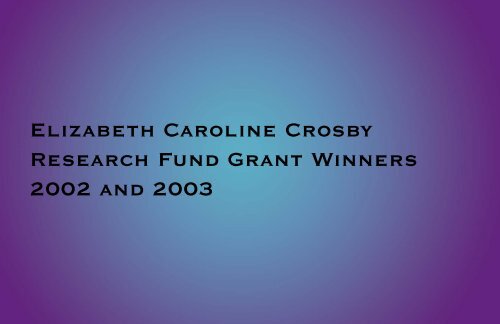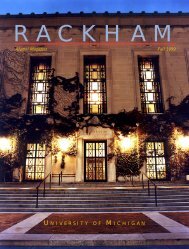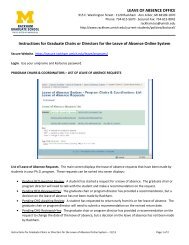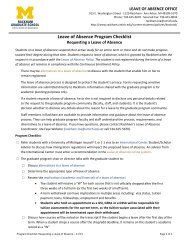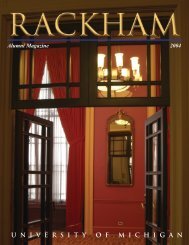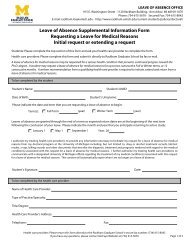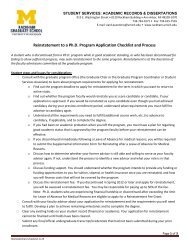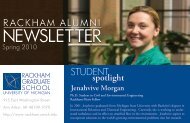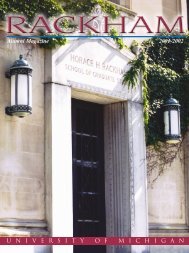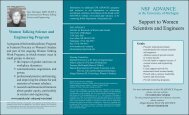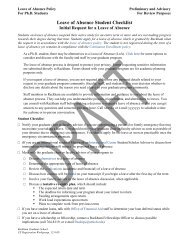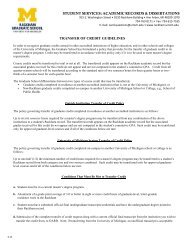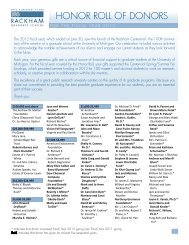Elizabeth Caroline Crosby Research Fund Grant Winners ... - advance
Elizabeth Caroline Crosby Research Fund Grant Winners ... - advance
Elizabeth Caroline Crosby Research Fund Grant Winners ... - advance
You also want an ePaper? Increase the reach of your titles
YUMPU automatically turns print PDFs into web optimized ePapers that Google loves.
<strong>Elizabeth</strong> <strong>Caroline</strong> <strong>Crosby</strong><br />
<strong>Research</strong> <strong>Fund</strong> <strong>Grant</strong> <strong>Winners</strong><br />
2002 and 2003
World-renowned Neuroanatomist<br />
<strong>Elizabeth</strong> <strong>Caroline</strong> <strong>Crosby</strong><br />
(1888-1983) began her long<br />
and distinguished career at<br />
the University of Michigan in<br />
1920. Starting as an Anatomy<br />
instructor, she rose through the<br />
ranks to become the first woman<br />
full professor of the medical school. A dedicated<br />
researcher and teacher, Dr. <strong>Crosby</strong> published<br />
extensively in comparative anatomy, and received<br />
several prestigious awards. She was the first woman<br />
to be awarded the Henry Russel Lectureship at<br />
the University of Michigan (1946); she earned the<br />
Henry Gray Award in Neuroanatomy in 1972, and<br />
the National Medal of Science in 1979. After her<br />
retirement in 1958, at age sixty-nine, Dr. <strong>Crosby</strong><br />
served as a clinical consultant at both the University<br />
of Michigan and University of Alabama, where a<br />
former student held a faculty position. Although she<br />
never married, she adopted an 11-year-old girl in<br />
1940 and another girl in 1944. She remained active<br />
in scientific work until the end of her life in 1983, at<br />
the age of ninety-four.<br />
<strong>Elizabeth</strong> <strong>Caroline</strong> <strong>Crosby</strong> <strong>Research</strong> Awards are<br />
available to help meet career-relevant needs of individual<br />
tenured and tenure-track faculty, if meeting those needs<br />
will help increase the retention or promotion of women<br />
science and engineering faculty. The fund, initially seeded<br />
by an NSF ADVANCE grant, supports a range of activities<br />
necessary for scholarly work in science and engineering<br />
fields. Competition for funds ($100,000 annually) takes<br />
place once each year. Applications may be for up to<br />
$20,000. Support may be requested for, but is not limited<br />
to, the following: extended travel to research sites or<br />
collaborators’ laboratories; lab space and equipment;<br />
research assistance; training of doctoral and postdoctoral<br />
students; teaching release time; summer salary; workrelated<br />
travel; long stays at field sites or long and late<br />
hours at labs; expenses for specialized child care to permit<br />
research activities. For complete application guidelines,<br />
please visit our website: http://www.umich.edu/~advproj/<br />
crosbyguide.html<br />
Applications must be received no later than February 16,<br />
2004. Awards will be announced by June 15, 2004.
Program<br />
ADVANCE Welcome<br />
Abigail J. Stewart, Director, ADVANCE Project<br />
Agnes Inglis Collegiate Professor of Psychology<br />
and Women's Studies<br />
Associate Dean for Academic Affairs, LS&A<br />
Remarks<br />
Sarah Winans Newman, Professor Emerita, Anatomy & Cell Biology<br />
January 13, 2004<br />
Michigan Room, Michigan League
Rebecca Bernstein<br />
Assistant Professor of Astronomy<br />
“Galaxy Formation and Intracluster Light”<br />
Two of the long-standing goals of observational cosmology are to understand the physical<br />
mechanisms which influence the evolution of galaxies, and to identify the fraction of<br />
mass in the universe which is baryonic matter (like hydrogen gas). Gravitationally bound<br />
clusters of galaxies are convenient testing sites to address both questions.<br />
Sensitive observations show that as much as 20% to 50% of the total starlight in any rich<br />
cluster of galaxies comes from stars which are not bound to any individual galaxy but<br />
are trapped in the gravitational potential well of the cluster. In other words, the light (and<br />
mass) in the intracluster stars is comparable to that in the galaxies themselves, but we do not explicitly understand<br />
their origin. By carefully quantifying the characteristics of the ICL --- its color, flux, profile, and substructure<br />
--- we can constrain the mechanisms driving galaxy evolution and also obtain a complete census of the baryonic<br />
content of clusters. Over the last four years, I have obtained a unique data set with which to quantify the ICL in<br />
clusters at a range of evolutionary states. <strong>Fund</strong>ing from a <strong>Crosby</strong> <strong>Research</strong> Award has provided the computer and<br />
salary support for graduate student Jessica Krick, with whom I have worked in the last 9 months to obtain our first<br />
results in this work.<br />
2003 <strong>Elizabeth</strong> <strong>Crosby</strong> Awardees
Katarina T. Borer<br />
Professor of Kinesiology<br />
“Using Exercise and Diet for Appetite Suppression in Postmenopausal Women”<br />
The project examines the feasibility of manipulating exercise and meal-taking in ways that could contribute to<br />
body fat loss. The information is important and urgent because of the global epidemic of obesity, and dismal,<br />
third-from-last national ranking of the state of Michigan in body fatness.<br />
As of December 2003, the first of the two planned studies is nearly complete. It produced provocative findings<br />
that exercise on an empty stomach produces hypoglycemia and increased plasma free fatty acids as well as<br />
secretion of recently-discovered gut hormone ghrelin, all physiological markers of energy need, but no increase<br />
in the sensation of hunger. The search for the cause of this exercise-induced suppression of hunger in the face of<br />
energy need will take the doctoral candidate <strong>Elizabeth</strong> Wuorinen on a dissertation research quest.<br />
The cost of the hormone and metabolite assays and subject fees for this study could not<br />
have been borne without the <strong>Elizabeth</strong> <strong>Crosby</strong> award. The pilot data have allowed me to<br />
apply for an NIH grant (currently under review), provided a phenomenon for dissertation<br />
research for <strong>Elizabeth</strong>, and motivation for a M.S. student from Taiwan, Po-Ju Lin, to take<br />
on the challenge of applying to the Kinesiology doctoral program (to carry out the second<br />
of the two planned studies.)<br />
2003 <strong>Elizabeth</strong> <strong>Crosby</strong> Awardees
Robyn Burnham<br />
Associate Professor of Ecology and Evolutionary Biology and of Geological Sciences<br />
Associate Curator for the Museum of Paleontology and the Biology Department<br />
“Population Structure of a Dominant Tropical Plant: Implications for Forest Dynamics and Conservation Status”<br />
The <strong>Crosby</strong> Award I received is devoted to expeditions to the Amazon Basin (Ecuador,<br />
Peru, Bolivia) to collect a dominant climbing plant, Machaerium cuspidatum, over its<br />
geographic range. The funds also will be used to continue molecular lab work on the<br />
samples collected to determine the degree of genetic difference between populations of<br />
the plants throughout its range. Machaerium cuspidatum is widespread and common in<br />
the intensely diverse area of Ecuador known as the Yasuní National Park and Huaorani<br />
Ethnic Reserve. Preliminary sampling suggested that either the plant was extremely<br />
variable from place to place (heterogeneous), or that it was indifferent to distance, and was<br />
genetically homogenous throughout the area. The difference between these two alternatives matters very much<br />
to conservation of high diversity forests. If heterogeneous, then every population matters for conservation of<br />
genetic diversity. If homogenous, we might propose that some diminution of its numbers will not affect the larger<br />
forest in a significant way. The <strong>Crosby</strong> funds already applied to this problem indicated that genetic variation is<br />
not related to distance between individuals, at least within the National Park, an area representing up to 100 km<br />
between samples. Remaining questions to be addressed in the coming year are: 1) at what distance does genetic<br />
differentiation appear within this species 2) are individuals in the National Park genetically identical to one<br />
another at a local scale 3) do individuals show more than one genetic signature, thus indicating error inherent<br />
in the methods used<br />
2003 <strong>Elizabeth</strong> <strong>Crosby</strong> Awardees
Amy Cohn<br />
Assistant Professor of Industrial and Operations Engineering<br />
“Large-Scale Optimization Techniques for Network Design Problems with Non-Linear Cost Functions”<br />
Network problems, in which we want to flow commodities over a system of nodes and arcs, appear in a wide array<br />
of application areas - telecommunications, supply chain logistics, transportation, and manufacturing, just to name<br />
a few. In many cases, the cost associated with this flow is a linear function of the amount on each arc. In more<br />
challenging cases, the cost may be a non-linear function of the flow on each arc - such problems are significantly<br />
more difficult to solve. In our research, we consider an even more difficult question, which has not previously<br />
appeared in the literature: how do we solve network design problems in which the cost associated with an arc<br />
depends not only on the flow across that arc, but also depends on the flow across other arcs as well<br />
The <strong>Crosby</strong> funds have been extremely valuable in helping to begin addressing this problem. Our research team<br />
includes two women graduate students, Lisa Schkade and Melinda Davey, as well as two women undergraduates,<br />
Caris Wong and Amanda Siegel, who were supported through the Sarah Marion Parker<br />
Scholars program. We were able to present preliminary results at a major conference<br />
in October, and it was quite satisfying to present a talk with 4 female co-authors! The<br />
<strong>Crosby</strong> funds helped in supporting the graduate students and made the conference travel<br />
possible. The <strong>Crosby</strong> funds have also enabled me to participate activities to help mentor<br />
undergraduate women, which included a panel discussion by women alumnae from the<br />
College of Engineering and a pre-exam study break with members of Phi Sigma Rho, the<br />
undergraduate engineering sorority.<br />
2003 <strong>Elizabeth</strong> <strong>Crosby</strong> Awardees
Rachel Goldman<br />
Associate Professor of Materials Science and Engineering<br />
“The Effects of Hydrogen on the Properties of Narrow Gap Nitride Semiconductor Alloys”<br />
The funds from the <strong>Elizabeth</strong> <strong>Caroline</strong> <strong>Crosby</strong> <strong>Research</strong> <strong>Fund</strong> have provided financial<br />
assistance which has benefited the scholarship and creative activities of my research group<br />
in a highly productive way. These funds enabled me to hire a total of ten undergraduate<br />
students, including four women, during Spring/Summer 2003. The contributions of<br />
several of these students have already been included in twenty contributed and invited<br />
presentations by my group at National and International Conferences during Fall Term<br />
2003. The visibility of this work has been beneficial, as it has led to more than five<br />
additional invitations to speak at International Conferences and top-ranked Universities.<br />
Furthermore, two of the undergraduate students have been selected as Finalists for the Intel Student <strong>Research</strong><br />
Contest for Undergraduate Students, scheduled to take place in March 2004.<br />
The remainder of the funds from the <strong>Elizabeth</strong> <strong>Caroline</strong> <strong>Crosby</strong> <strong>Research</strong> <strong>Fund</strong> have been used to purchase<br />
several components and instruments associated with a new plasma chamber for our molecular beam epitaxy<br />
chamber. This new plasma chamber will enable us to control the incorporation of nitrogen and hydrogen during<br />
the epitaxial growth of dilute nitride semiconductor alloys. This new capability will enable us to reveal the<br />
effect of hydrogen on the properties of dilute nitride semiconductor alloys that are promising for a wide range of<br />
optoelectronic applications.<br />
2003 <strong>Elizabeth</strong> <strong>Crosby</strong> Awardees
Ingrid Hendy<br />
Assistant Professor of Geological Sciences<br />
“Eastern Tropical Pacific Intermediate Ocean History”<br />
I proposed examining low oxygen sediments in a series of deep ocean sediment cores from the Gulf of Tehuantepec,<br />
Mexico. <strong>Research</strong> completed during the my tenure as a Postdoctoral Fellow at the University of British Columbia,<br />
Canada has established the first record of low oxygen sediments in the Eastern Tropical Pacific. I began as an<br />
assistant professor at the University of Michigan in September 2002 and am now attempting to secure funds from<br />
federal sources to establish a research program. The funds requested from the Crobsy Award will be used to bridge<br />
to future research and fund raising efforts.<br />
2003 <strong>Elizabeth</strong> <strong>Crosby</strong> Awardees
Trachette Jackson<br />
Assistant Professor of Mathematics<br />
“Multiphase Mechanics of Tumor Encapsulation”<br />
The mechanisms by which a tumor becomes encapsulated as a continuum of cells or<br />
as several lobes of different sizes, separated by connective tissue, is an interesting,<br />
important, and unsolved phenomenon in tumor biology. Despite the importance of capsule<br />
formation, little is known about the process by which they arise. In order to compare two<br />
leading theories which attempt to explain how tumor capsules form, I have developed<br />
a mathematical modeling framework to describe tumor growth, encapsulation, multiple<br />
lobe formation, and transcapsular spread based on the physical (mechanical) forces and<br />
cellular interactions involved.<br />
During the first year of my tenure-track appointment, I applied for an NSF grant to fund this research project.<br />
Although my proposal was funded, the program director cited the early stage of my academic career (at the time<br />
I was only two years post-Ph.D.) as reason not to fund graduate students, postdoctoral associates, and teaching<br />
reductions as part of the grant. The <strong>Elizabeth</strong> <strong>Caroline</strong> <strong>Crosby</strong> <strong>Research</strong> Award award allowed me to support<br />
two graduate students for three months over the summer. Each focused on a separate and specific aspect of my<br />
research. I feel strongly that being granted this award in the semester following my third-year review proved<br />
invaluable to my tenure case by allowing me to devote more of my professional time to the <strong>advance</strong>ment and<br />
advertisement of my research.<br />
2003 <strong>Elizabeth</strong> <strong>Crosby</strong> Awardees
Smadar Karni<br />
Associate Professor of Mathematics<br />
“Women in Applied Mathematics”<br />
My award is being used to run a special Speaker Series celebrating the achievements of women in applied<br />
mathematics. The aim of the series is to promote the visibility of women applied mathematics, to bring to the<br />
limelight the breadth and excellence of their scientific contributions, and to be inspired by their accomplishments.<br />
Ultimately, it is hoped that it will lead to an increase in the share of women applied mathematicians among the<br />
department's permanent faculty.<br />
As part of the visit, the speakers are invited to have lunch with the women graduate students, postdocs and faculty,<br />
to have a chance to meet and chat informally about career related issues. The lunches were attended by some 15-<br />
20 people each, and provide an opportunity to hear words of wisdom from the speaker, but equally importantly<br />
provide a chance for us to meet with each other. The series was inaugurated by Prof. Cathleen Morawetz, a former<br />
President of the American Mathematical Society, and was toasted to a wonderful start by<br />
Provost Paul Courant. The series will continue to run in the winter term and during next<br />
year.<br />
2003 <strong>Elizabeth</strong> <strong>Crosby</strong> Awardees
Elizaveta Levina<br />
Assistant Professor of Statistics<br />
“Classification of High-Dimensional Data with Applications to Texture”<br />
The research supported by the <strong>Crosby</strong> Award is on pattern recognition for highdimensional<br />
data, with applications to imaging. Massive amounts of data collected in<br />
the modern world have created a number of new challenges for statisticians, and new<br />
theoretical and practical tools need to be developed to deal with high-dimensional data,<br />
and particularly with the situation when the number of variables is large relative to the<br />
number of observations. This problem occurs in many applications (gene expression<br />
data, medical imaging, remote sensing, financial data, and chemometrics, to name a few).<br />
While a few, mostly heuristic, algorithms exist for dealing with such data, the amount of<br />
research into the issue to date is limited.<br />
The <strong>Crosby</strong> Award supported my research on this subject by providing teaching release for Fall 2003, summer<br />
salary, and travel support. It allowed me to do several things that would have likely not been accomplished<br />
otherwise, or would have taken much longer: (a) to branch out into a somewhat different research direction; (b)<br />
to find collaborators at the University of Michigan (in Mechanical Engineering) and start working with them on<br />
applications of my research to a practical problem in quality control from image data; (c) give several invited<br />
seminars, and participate in a special program on high-dimensional data. It has been extremely helpful to have<br />
the extra funds and time, particularly at this early stage of my tenure track.<br />
2003 <strong>Elizabeth</strong> <strong>Crosby</strong> Awardees
Mingyan Liu<br />
Assistant Professor, Electrical Engineering and Computer Science<br />
“<strong>Fund</strong>amental Stochastic Problems in Wireless Sensor Networks”<br />
The goal of this research project is to formulate certain stochastic problems arising from data search and retrieval<br />
in large-scale wireless sensor networks. The award helped me to conduct research with a graduate student during<br />
the summer of 2003 in this direction. It will also likely fund the travel of the student to attend a conference and<br />
present a paper as a direct result of this research. Specifically, we investigated the problem of searching/locating<br />
a piece of data/file/object in a large network. We formulate this as a stochastic control problem, which allows<br />
us to derive search strategies that achieve this goal in a most efficient and least costly way. So far our work has<br />
focused on the class of flooding search strategies, where a query is progressively flooded to the network (with<br />
increasing range of flooding) till the target data/object is found. We have found optimal search strategies for given<br />
probability distribution of the target data. Currently we are in the process of developing search strategies that aim<br />
at optimizing the worst-case performance when the distribution of target data/object is not known a priori. We<br />
believe this work promises significant impact on efficient data search not only in wireless<br />
sensor networks, but also in the more generic wired networks, e.g., the Internet, especially<br />
within the context of peer-to-peer networking. Our next step would be to conduct similar<br />
studies for the class of linear search or random walk based search strategies.<br />
2003 <strong>Elizabeth</strong> <strong>Crosby</strong> Awardees
Laura Olsen<br />
Arthur F. Thurnau Professor, Associate Professor and Associate Chair of <strong>Research</strong> and Facilities<br />
Department of Molecular, Cellular, and Developmental Biology<br />
“Molecular and Ultrastructural Analysis of Autophagy in Plants”<br />
Autophagy is a dynamic process in which cytoplasm and organelles are sequestered in<br />
lysosomes or vacuoles for degradation and recycling. Very little is known about this<br />
process in plants. The long-term goal of the project is to characterize the molecular<br />
and ultrastructural events associated with the onset of autophagy in response to nutrient<br />
starvation or stress conditions in plants. This project is the beginning of a new research<br />
direction for my lab. The <strong>Crosby</strong> Award provided summer support for students at three<br />
levels of their education – an <strong>advance</strong>d graduate student, who helped train the other<br />
students and acted as a role model for the others; an incoming graduate student who<br />
had begun working on autophagy as an undergraduate with my collaborator at Eastern Michigan University;<br />
and a new undergraduate Honors student. As an "inter-generational" team, we all worked together to generate<br />
preliminary data needed to apply for more extensive extramural funding. Without the <strong>Crosby</strong> Award to provide<br />
this summer support I would have been unable to make such a positive and concrete start on the project. We made<br />
good progress on each of our objectives. I am now able to begin planning a full-scale grant proposal, along with<br />
my collaborators within my department and at Eastern Michigan University and Central Michigan University, to<br />
be submitted to the National Science Foundation. Thus, the <strong>Crosby</strong> Award provided seed money for a new and<br />
exciting research program that I hope to direct for many years to come.<br />
2003 <strong>Elizabeth</strong> <strong>Crosby</strong> Awardees
Rosemary Rochford<br />
Assistant Professor of Epidemiology<br />
“Burkitt’s lymphoma in Kenya”<br />
My main interest lies in the pathogenesis of Epstein-Barr virus associated malignancies. My research on EBV<br />
has focused primarily on the EBV-associated immunoblastic lymphomas and lymphoproliferative disorders that<br />
arise in individuals with AIDS or in transplant patients undergoing immunosuppressive therapy. More recently,<br />
we have also initiated studies on endemic Burkitt’s lymphoma as well as studies on viral pathogenesis following<br />
infection of mice with MHV-68.<br />
Dr. Rochford left the University of Michigan in Fall, 2003 and is now at SUNY Upstate Medical University.<br />
2003 <strong>Elizabeth</strong> <strong>Crosby</strong> Awardees
Michele Swanson<br />
Associate Professor of Microbiology and Immunology<br />
Given the dearth of women scientists, it is imperative that each maximizes her impact.<br />
To do so, one must not only secure colleagues’ respect through scientific achievement,<br />
but also become an informed advocate for the minority. With support from the <strong>Elizabeth</strong><br />
C. <strong>Crosby</strong> <strong>Research</strong> Award, I have devoted my sabbatical to gaining expertise in both<br />
the biology of bacterial biofilm communities and the challenge of gender equity. As an<br />
Invited Professor at the Pasteur Institute, I am affiliated with the laboratory of Jean-Marc<br />
Ghigo, who applies genetic methods to analyze biofilm development. My residence in<br />
Paris has also promoted interaction with the European community, including invited<br />
seminars at Oxford University in England; the Université de Poitiers, Universite Mediterranee de Marseille-<br />
Luminy, and Pasteur Institute in France; the Max Planck Institute, University of Ulm, and University of Tubingen<br />
in Germany; and conferences in Switzerland, Germany, and Spain. Already four of these meetings have led to<br />
new collaborations between my laboratory and European scientists with complementary expertise. Freedom<br />
from most teaching and service has allowed me to devote time to literature relevant to gender equity. By reading<br />
books from the practical manual At the Helm, a Laboratory Navigator by Kathy Barker to the inspirational<br />
memoir Madame Secretary by Madeleine Albright, and from my numerous personal conversations with women<br />
scientists in England, Germany, and France, I am better prepared to advocate for equality in academic science.<br />
Finally, I am especially grateful for the opportunity to share the adventures of a year abroad with my teenage<br />
daughter and son and with my husband.<br />
2003 <strong>Elizabeth</strong> <strong>Crosby</strong> Awardees
Maria Clara Castro<br />
Assistant Professor of Geological Sciences<br />
The <strong>Elizabeth</strong> <strong>Caroline</strong> <strong>Crosby</strong> <strong>Research</strong> <strong>Fund</strong> has supported a post-doctoral fellow, Delphine Patriarche, who is<br />
undertaking research with me on regional groundwater flow and transport modeling. The goal of this study is to<br />
investigate the use of three-dimensional models for providing additional constraints necessary to reduce the nonuniqueness<br />
problems associated with 2D models. Such models provide higher resolution of the heterogeneities<br />
present in the groundwater systems and thus, allow discrimination of which parameters play a major role in<br />
influencing the movement of groundwater at a regional scale.<br />
To this end, we have constructed a three-dimensional finite element model, the most complex groundwater 3D<br />
model ever built, representing four formations in southwest Texas. This 3D model, which covers a surface of<br />
~7000 km 2 and comprises more than 5 million elements, has allowed simulation of coupled fluid flow and 4He<br />
transport in steady-state conditions. Our results show that both depth and changes in lithological facies play a major<br />
role in groundwater flow movement as they are directly related to variations in hydraulic<br />
conductivity. This work is significant because it increases our general understanding of<br />
regional groundwater flow movement, which will positively impact a diversity of fields<br />
including management of groundwater resources, contaminated aquifer remediation and<br />
reconstruction of paleoclimates. The first results of this research were presented to the<br />
scientific community at the AGU Fall Meeting 2003 (December 8-12th) and a research<br />
paper will be submitted for publication to Water Resources <strong>Research</strong> in early 2004.<br />
2002 <strong>Elizabeth</strong> <strong>Crosby</strong> Awardees
Aline Cotel<br />
Assistant Professor of Civil and Environmental Engineering<br />
The research project started as an all-women collaboration between an undergraduate,<br />
graduate student and assistant professor and represented the first phase in a larger scale<br />
endeavor related to river restoration. The students performed laboratory experiments<br />
related to flow around structures commonly encountered in streams. This was continued<br />
with field work at the University of Michigan Biological Station this past summer and<br />
partially funded another female undergraduate student (Lisa Rayle).<br />
<strong>Fund</strong>ing provided by the <strong>Crosby</strong> award has allowed me to broaden my research interests<br />
and initiate collaboration with Prof. Paul Webb in the School of Natural Resources and the Environment. To<br />
date, this has proven to be the most productive collaboration I have been able to establish since my arrival at the<br />
University of Michigan. Combining biology and fluid mechanics as well as laboratory and field experiments<br />
is opening new avenues in the study of fish dynamics and habitat restoration in general. Proposals have been<br />
submitted to the National Science Foundation and local organizations. This area of research is quickly becoming<br />
my primary focus, all thanks to the <strong>Crosby</strong> award.<br />
2002 <strong>Elizabeth</strong> <strong>Crosby</strong> Awardees
Kimberlee Kearfott<br />
Professor of Nuclear Engineering and of Biomedical Engineering<br />
This award was used to obtain equipment for a laboratory to enable the identification and measurement of<br />
small amounts of unknown radioisotopes. This capability is useful for radioactivity expected to be encountered<br />
in environmental samples as a result of natural variation in background, radiation fallout, normal industrial<br />
operations, accidents, and potential terrorist events. The funds provided by the <strong>Crosby</strong> Award were supplemented<br />
by the Department of Nuclear Engineering, the College of Engineering Associate Dean for Academic Affairs,<br />
the College of Engineering Associate Dean for <strong>Research</strong>, and the Office of the Vice President for <strong>Research</strong>. As<br />
a result, it was possible to obtain an alpha spectroscopy system, a specialized support system for making field<br />
measurements, air sampling equipment, thermoluminescent materials, and radon gas measurement systems. In<br />
addition, funds enabled the repair of repair several gamma ray spectroscopy and modular nuclear instrumentation<br />
systems which were obtained by donation to the laboratory. The newly equipped laboratory will enable research<br />
in applied radiation measurements methods. During Fall 2003, four graduate and 12 undergraduate students<br />
performed research of various types in the laboratory.<br />
2002 <strong>Elizabeth</strong> <strong>Crosby</strong> Awardees
Joanna Mirecki Millunchick<br />
Assistant Professor of Materials Science and Engineering<br />
The aim of this project was to raise the visibility of women in the field of Materials<br />
Science. This was done primarily by bringing scientists to the University of Michigan<br />
to participate in the Women in Materials Science Speaker Series, which showcased<br />
the accomplishments of woman scientists, and fostered mentoring and networking<br />
opportunities. The scientists who were featured ranged in rank and experience from the<br />
most junior, such as Kalina Hristova, an assistant professor at Johns Hopkins, to the most<br />
senior, such as Professor Kathy Faber who was the current chair of the Materials Science<br />
and Engineering Department at Northwestern University. We also brought Professor<br />
Millie Dresselhaus as our Van Vlack Lecturer. This is the highest honor bestowed by the Department of Materials<br />
Science and Engineering, and is given to the individual that is not only a renowned Materials Scientist, but also an<br />
exemplary educator. Professor Dresselhaus is without question beyond reproach in both categories. This funding<br />
was also used by a female assistant professor and several female graduate and undergraduate students to travel to<br />
conferences and universities to publicize their research.<br />
2002 <strong>Elizabeth</strong> <strong>Crosby</strong> Awardees
Kristen Moore<br />
Assistant Professor of Mathematics<br />
There is considerable societal need and student demand for research and educational programs in Actuarial and<br />
Financial Mathematics (AFM) that keep pace with the increasing complexity of the financial environment and the<br />
mathematical tools available for its analysis. The <strong>Crosby</strong> Award helped me to integrate my background from my<br />
first career in insurance with my Ph.D. training in Partial Differential Equations in order to investigate important<br />
open questions and enhance our department’s curriculum in the burgeoning field of AFM.<br />
In the case of financial markets, the celebrated Black-Scholes pricing theory provides a dynamic strategy for<br />
pricing and hedging against the risk of derivative securities such as options. <strong>Fund</strong>amental to the Black-Scholes<br />
model is the assumption of a complete market; however, insurance markets are incomplete. To date, there is no<br />
universal theory that addresses dynamic pricing of risk in incomplete markets. With teaching release time from<br />
the <strong>Crosby</strong> Award, Dr. Virginia Young and I built on her earlier work using equivalent utility methods to price<br />
dynamic risks in an incomplete market. The results of this study are detailed in our paper<br />
that appeared recently in the journal Insurance: Mathematics and Economics. In addition,<br />
we are using techniques from stochastic optimal control to study optimal strategies for an<br />
investor who seeks to achieve an objective such as minimizing the probability of financial<br />
ruin during her lifetime. These investigations are timely in light of the increased longevity<br />
of our aging population, recent pension fund failures, and the continuing trend toward<br />
defined contribution retirement plans under which individuals assume all investment<br />
risk.<br />
2002 <strong>Elizabeth</strong> <strong>Crosby</strong> Awardees
Geneva Omann<br />
Associate Professor of Surgery and Biological Chemistry<br />
Her <strong>Crosby</strong> Award will support research to develop high throughput assays for measuring<br />
G-protein coupled receptor binding and processing.<br />
Strategies to determine receptor binding and processing kinetics will be utilized to<br />
begin to understand the role these kinetic play in drug action. Three faculty women will<br />
participate in this project, and their careers will be <strong>advance</strong>d in the following ways: 1) The<br />
completion of the work will <strong>advance</strong> the standing of the faculty members in the field of<br />
receptor biology and contributions here will strengthen their portfolios. 2) The completed<br />
work may lead to new strategies for drug design and enhance the faculty members’<br />
abilities to compete for additional funding from pharmaceutical companies, private foundations and government<br />
agencies.<br />
2002 <strong>Elizabeth</strong> <strong>Crosby</strong> Awardees
Ana I. Sirviente<br />
Naval Architecture and Marine Engineering Department<br />
The <strong>Elizabeth</strong> <strong>Caroline</strong> <strong>Crosby</strong> <strong>Research</strong> Award allowed me to partially fund the work of an outstanding female<br />
doctoral student on her work in two different research areas. One was to complete an ongoing experimental<br />
study on free surface turbulent flows. Such study produced a very detailed experimental data set that is allowing<br />
the development of a modified more effective turbulence closure to give a more accurate representation of the<br />
turbulence field near a deformable free surface. The second study was conducted on the area of polymer drag<br />
reduction in a re-circulating channel flow with polymer injected at the test section entrance. The aim of the study<br />
was to gain a better understanding of the physical processes that take place in polymer-turbulence interaction. It<br />
was found that the mixing taking place in a shear flow can induce macro-molecular polymer structures. Such<br />
polymer structures are much better drag reduction agents than single polymer molecules.<br />
2002 <strong>Elizabeth</strong> <strong>Crosby</strong> Awardees
ADVANCE Staff:<br />
Janet Malley, Evaluation<br />
Laura Reese, Evaluation and Implementation<br />
Robin Stephenson, Implementation<br />
Abigail Stewart, PI, Implementation<br />
Ching-Yune Sylvester, Evaluation<br />
<strong>Elizabeth</strong> <strong>Caroline</strong> <strong>Crosby</strong> Selection Committee<br />
Selection committee membership varies year by year, but has included these individuals at some time in the past<br />
three years:<br />
Cinda-Sue Davis, Program Director, Women in Science & Engineering<br />
Deborah Goldberg, Professor and Chair, Ecology and Evolutionary Biology<br />
Sarah Winans Newman, Professor Emerita, Anatomy & Cell Biology<br />
Susan Nolen-Hoeksema, Director, Institute for <strong>Research</strong> on Women and Gender<br />
Pamela Raymond, Co-PI ADVANCE, Senior Counselor to the Provost, Cell and Developmental Biology<br />
Lisa Tedesco, Professor of Dentistry, Vice President and Secretary of the University<br />
Steering Committee<br />
Stephen Director (Co-PI, Dean of Engineering)<br />
Allen Lichter (Co-PI, Dean of Medicine)<br />
Terrence McDonald (Co-PI, Dean of Literature, Science & Arts)<br />
Pamela Raymond (Co-PI, Senior Counselor to the Provost, Cell and Developmental Biology)<br />
Abigail Stewart (PI, Psychology, Women’s Studies)
NSF ADVANCE<br />
Institute for <strong>Research</strong> on Women and Gender<br />
University of Michigan<br />
1136 Lane Hall<br />
Ann Arbor, MI 48109-1290<br />
734-764-9533 * <strong>advance</strong>project@umich.edu<br />
www.umich.edu/~advproj<br />
The University of Michigan, as an Equal Opportunity/Affirmative Action employer, complies with all applicable rederal and state laws regarding non-discrimination and<br />
affirmative action, including Title IX of the Education Amendments of 1972 and Section 504 of the Rehabilitation Act of 1973. The University of Michigan is committed<br />
to a policy of race, sex, color, religion, creed, national origin or ancestry, age, marital status, sexual orientation, disability, or Vietnam-era veteran status in employment,<br />
educational programs and activities, and admissions. Inquiries or complaints may be addressed to the University’s Director of Affirmative Action, Title IX and Section<br />
504 Coordinator, 4005 Wolverine Tower, Ann Arbor, MI 48109-1281. (734)763-0235. TDD (734)763-2891.


